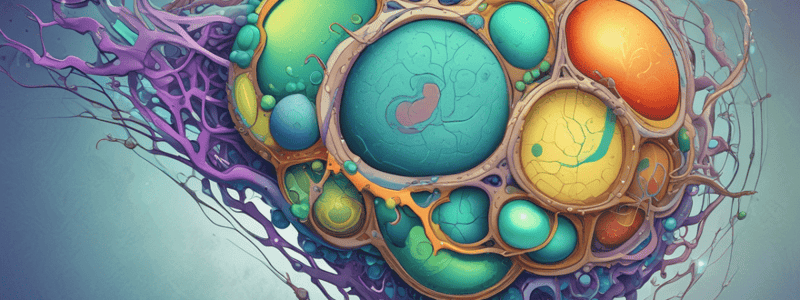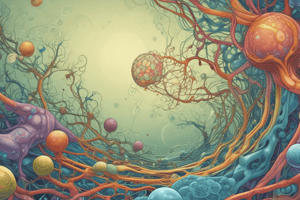Podcast
Questions and Answers
What is the primary function of the protein molecules in the cell?
What is the primary function of the protein molecules in the cell?
- To bind to other molecules specifically
- To provide structure to the cell membrane
- To facilitate the operation of cellular mechanisms (correct)
What is the main component of the cell membrane?
What is the main component of the cell membrane?
- Carbohydrates
- Proteins
- Phospholipids (correct)
- Triglycerides
What is the function of the Golgi apparatus?
What is the function of the Golgi apparatus?
- Cell signaling
- Protein synthesis
- Lipid synthesis
- Processing and forming lysosomes (correct)
What is the primary function of lysosomes?
What is the primary function of lysosomes?
What is the function of peroxisomes?
What is the function of peroxisomes?
What is the function of the nucleus?
What is the function of the nucleus?
What is a function of the cytoskeleton?
What is a function of the cytoskeleton?
What is the function of mitochondria?
What is the function of mitochondria?
What is the function of the cell membrane?
What is the function of the cell membrane?
What is the primary function of cholesterol in the cell membrane?
What is the primary function of cholesterol in the cell membrane?
What is the main function of water in the cell?
What is the main function of water in the cell?
What is the main difference between eukaryotic and prokaryotic cells?
What is the main difference between eukaryotic and prokaryotic cells?
Which of the following is NOT a component of the cytoskeleton?
Which of the following is NOT a component of the cytoskeleton?
What is the function of the plasma membrane?
What is the function of the plasma membrane?
What is the percentage of fat in a fat cell?
What is the percentage of fat in a fat cell?
What is the name of the membrane that separates the nucleus from the cytoplasm?
What is the name of the membrane that separates the nucleus from the cytoplasm?
Which of the following is NOT a component of a cell?
Which of the following is NOT a component of a cell?
What is the approximate percentage of water in a typical bacterial cell?
What is the approximate percentage of water in a typical bacterial cell?
What is the term for the fluid medium that surrounds the cell?
What is the term for the fluid medium that surrounds the cell?
What is the primary function of phospholipids in the cell membrane?
What is the primary function of phospholipids in the cell membrane?
Which of the following ions is present in higher quantities inside the cell?
Which of the following ions is present in higher quantities inside the cell?
What is the function of peripheral proteins in the cell membrane?
What is the function of peripheral proteins in the cell membrane?
What is the role of the uneven distribution of ions between the opposing sides of the cell membrane?
What is the role of the uneven distribution of ions between the opposing sides of the cell membrane?
What is the primary function of triglycerides in the cell?
What is the primary function of triglycerides in the cell?
What is the role of the endoplasmic reticulum in the cell?
What is the role of the endoplasmic reticulum in the cell?
What is the function of the Golgi apparatus in the cell?
What is the function of the Golgi apparatus in the cell?
What is the primary function of integral proteins in the cell membrane?
What is the primary function of integral proteins in the cell membrane?
What is the primary function of the cytosol in the cell?
What is the primary function of the cytosol in the cell?
What type of molecule is water, except in fat cells?
What type of molecule is water, except in fat cells?
What is the main fluid medium for most cells?
What is the main fluid medium for most cells?
What separates the cytoplasm from the surrounding fluid in a eukaryotic cell?
What separates the cytoplasm from the surrounding fluid in a eukaryotic cell?
What is the primary role of proteins in the cell?
What is the primary role of proteins in the cell?
Which of the following is a function of the plasma membrane?
Which of the following is a function of the plasma membrane?
What is the function of the membrane potential?
What is the function of the membrane potential?
What is the role of the endoplasmic reticulum in the cell?
What is the role of the endoplasmic reticulum in the cell?
What is the function of lysosomes?
What is the function of lysosomes?
What is the function of peroxisomes?
What is the function of peroxisomes?
What is the primary function of carbohydrates in the cell?
What is the primary function of carbohydrates in the cell?
Flashcards are hidden until you start studying
Study Notes
Cell Composition
- The cell consists of five main substances: water, ions, proteins, lipids, and carbohydrates.
- Water is the main fluid medium, making up 70% of the cell's composition.
- Ions are charged molecules that get along well with water, providing inorganic chemicals for cellular reactions.
- Proteins are the second most abundant substance, determining their function through their 3D shape.
- Lipids are key components of cells, forming the cell membrane and intracellular membrane barriers.
- Carbohydrates play a major role as a source of energy, with small amounts stored inside cells.
Cell Membrane
- The plasma membrane is composed of lipids and proteins.
- Lipids in the cell membrane include phospholipids, sphingolipids, and cholesterol.
- Proteins in the cell membrane are either integral or peripheral, acting as channels, transporters, and receptors.
- The cell membrane has three main functions: compartmentalization, selective transport, and information processing.
Cytoplasm and Organelles
- Cytoplasm is the space between the nucleus and plasma membrane, consisting of organelles and cytosol.
- Cytosol is the fluid containing mainly water, dissolved proteins, electrolytes, and glucose.
- Organelles include:
- Endoplasmic reticulum (ER): responsible for lipid and protein biosynthesis.
- Granular ER (Rough ER): synthesizes proteins.
- Agranular ER (Smooth ER): synthesizes lipids.
- Golgi apparatus: processes and forms lysosomes and secretory vesicles.
- Lysosomes: site of intracellular digestion.
- Peroxisomes: involved in lipid biosynthesis and degradation of amino acids and fatty acids.
- Mitochondria: generates ATP through oxidative phosphorylation.
Cytoskeleton
- The cytoskeleton is a network of fibrillar proteins organized into filaments or tubules.
- Components include microfilaments, microtubules, and intermediate filaments.
- Functions of the cytoskeleton include:
- Maintaining cell shape.
- Facilitating cell division.
- Enabling movement.
- Providing a track-line system for molecular movement.
- Offering mechanical strength.
Nucleus
- The nucleus is the control center of the cell.
- It contains:
- Nuclear membrane or envelope.
- Nucleolus.
- Genetic material (DNA, chromosomes, and chromatin).
- The nucleus controls cellular growth, maturation, division, and death.### Ions
- Higher quantities of ions are found inside cells, including:
- Potassium
- Magnesium
- Phosphate
- Sulfate
- Bicarbonate
- Smaller quantities of ions are found inside cells, including:
- Sodium
- Chloride
- Calcium
- Ions are charged molecules that get along well with water (hydrophilic) and provide inorganic chemicals for cellular reactions.
- Ions are necessary for the operation of some cellular mechanisms, such as:
- Transmission of electrochemical impulses in nerve and muscle cells
Proteins
- Proteins are the second most abundant substance in the cell (after water).
- The 3-dimensional shape of a protein determines its function.
- Proteins can bind to other molecules very specifically (lock-and-key) and can change shape and alter binding properties and function.
- All physiological changes are mediated by proteins.
- Proteins can be:
- Structural (e.g., cytoskeleton)
- Functional (e.g., enzymes, transport proteins, signaling proteins)
Lipids
- Lipids are key components of cells and are found in:
- Plasma membrane
- Nuclear membrane
- Endoplasmic reticulum
- Golgi apparatus
- Endosomes
- Lysosomes
- The diversity of lipids is similar to that of proteins, but lipids have not been as well studied.
- Lipids are insoluble in water and form the cell membrane and intracellular membrane barriers that separate different cell compartments.
- Important lipids include:
- Phospholipids
- Cholesterol
- Phospholipids spontaneously form bilayers when in aqueous solution.
- Cholesterol enhances the barrier properties of the lipid bilayer and makes it more stable.
Carbohydrates
- Carbohydrates have little structural function, but play a major role as a source of energy.
- Carbohydrates are stored in small amounts inside cells and can be stored as glycogen.
- Glucose from the extracellular fluid (ECF) is readily available to cells.
The Cell Membrane
- The cell membrane is composed almost entirely of lipids and proteins.
- Intrinsic membrane proteins are embedded in the lipid bilayer.
- The outer surface of the cell membrane contains carbohydrates in combination with lipids and proteins.
- The cell membrane is impermeable to water-soluble substances.
- Lipids in the cell membrane include:
- Phospholipids
- Sphingolipids
- Cholesterol
- Proteins in the cell membrane include:
- Integral proteins (permanently attached to the membrane)
- Peripheral proteins (attached to one surface of the membrane)
Organelles
- Organelles are found in the cytoplasm and include:
- Endoplasmic reticulum (ER)
- Golgi apparatus
- Lysosomes
- Peroxisomes
- Mitochondria
- Each organelle has a specific function, such as:
- Protein synthesis (ER)
- Lipid synthesis (ER)
- Cell signaling (ER)
- Protein modification and packaging (Golgi apparatus)
- Intracellular digestion (Lysosomes)
- Oxidation reactions (Peroxisomes)
- Energy production (Mitochondria)
Cytoplasm/Cytosol
- Cytoplasm is the space between the nucleus and the plasma membrane.
- Cytosol is the fluid in which organelles of the cell reside.
- Cytosol contains mainly:
- Water
- Dissolved proteins
- Electrolytes
- Glucose
- Cytoplasm contains organelles and plays a role in:
- Cell signaling
- Metabolic reactions
- Cell division
Nucleus
- The nucleus is the control center of the cell.
- The nucleus contains:
- Nuclear membrane or envelope
- Nuclear pores
- Nucleolus
- Genetic material (DNA)
- The nucleus controls cellular growth, maturation, division, and death.
Microanatomy and Embryology
- Microanatomy is the study of the cells and tissues of the body and how they integrate to form organs.
- Embryology is the study of the development of a new individual from embryo to fetus.
- Microanatomy and embryology are important in understanding the structure and function of cells and tissues.
Studying That Suits You
Use AI to generate personalized quizzes and flashcards to suit your learning preferences.




